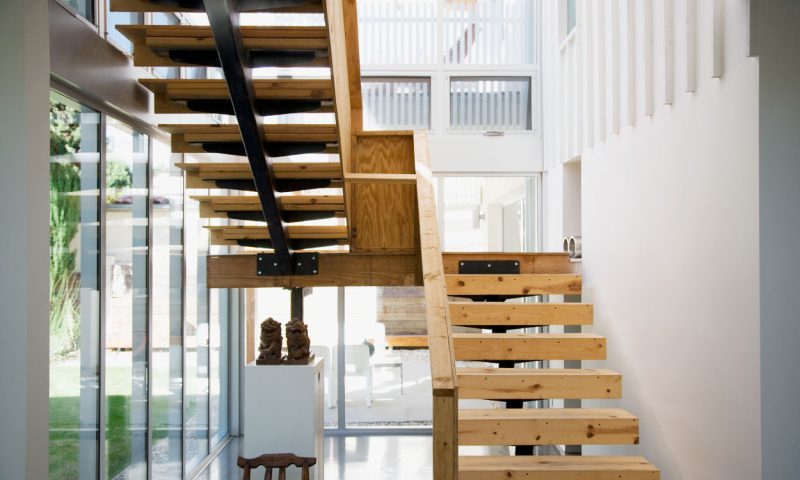Open-plan living spaces are a hallmark of contemporary home design, offering fluidity and a sense of openness. A key element in these spaces is the integration of staircases, which serve both functional and aesthetic purposes. This article delves into how you can seamlessly incorporate vertical connections into your open-plan home.
The concept of open-plan living has gained immense popularity as it breaks down barriers between traditional rooms, creating a spacious environment that encourages interaction. The challenge lies in ensuring that each area within this open space flows naturally into the next, maintaining cohesion throughout. Staircases often play a critical role in achieving this fluidity, serving as vital connectors between different levels of the home. By thoughtfully designing these vertical connections, you can enhance both the functionality and aesthetics of your living space.
The Roles of Staircases In Open-plan Homes
In open-plan homes, staircases are not merely a means to move between floors; they are integral to the design narrative. They offer a unique opportunity to introduce vertical movement while contributing significantly to the visual appeal of the interior. With careful design considerations, staircases can be transformed into stunning architectural features that define the character of an open-plan space.
Staircases serve dual purposes: they provide practical connectivity and offer an opportunity for artistic expression. Their placement within an open-plan layout should consider both traffic flow and sightlines to ensure they complement the space rather than disrupt it. By selecting materials and finishes that harmonise with the surrounding décor, staircases can enhance the overall aesthetic while maintaining their essential function.
Moreover, when designed thoughtfully, staircases can become focal points that draw attention and anchor the design of an entire room. Whether through innovative use of materials or creative lighting solutions, staircases can elevate the ambiance of an open-plan home by adding depth and dimension.
Strategies For Integrating Vertical Connections
Integrating vertical connections like staircases into an open-plan layout involves several design considerations. Material choice is crucial; using materials that resonate with other elements in the room ensures a cohesive look. For instance, if your open-plan space features natural wood accents, incorporating similar wood tones in your staircase can unify the design.
Color schemes also play a significant role in creating harmony between different areas. Opting for a consistent palette across your space, including your staircase, can help maintain visual continuity. Consider using complementary colors or subtle contrasts to highlight the staircase as a feature without overwhelming other elements.
Architectural style is another important factor to consider. The staircase design should reflect and enhance the overall style of your home; be it minimalist, traditional, or modern. By aligning these design elements with your architectural vision, you create a seamless integration that respects both form and function.
Maximising Space Around Staircases
Space optimisation is essential when incorporating staircases into open-plan homes. One effective strategy is to utilise the area beneath or around the staircase for additional storage or functional zones. Built-in shelving or cupboards beneath stairs can provide valuable storage without encroaching on living space.
Maintaining fluidity in layout is critical to preserving the openness of an open-plan design. Arranging furniture strategically around staircases can create distinct yet connected areas that facilitate easy movement. Consider using furniture with low profiles or transparent materials to prevent obstruction and maintain sightlines.
Another tip is to employ multifunctional furniture pieces that adapt to various needs. A staircase landing could double as a reading nook or workspace, maximising utility without sacrificing style or space efficiency.
Staircases as Focal Points
A well-designed staircase can serve as a dramatic focal point in an open-plan home. Unique materials such as glass balustrades or wrought iron details can add texture and interest while still aligning with the overall aesthetic. Lighting is another powerful tool, strategically placed spotlights or LED strips can accentuate features like floating steps or artistic railings.
The use of artwork or sculptural elements on or near staircases can further enhance their visual impact. Incorporating these artistic features allows you to personalise your space while showcasing creativity. Thoughtfully designed staircases become conversation starters that reflect individual style within an architectural context.
Ultimately, creating a striking focal point with your staircase involves balancing bold design choices with practical considerations to ensure it complements rather than overwhelms your living area.
Prioritising Safety and Compliance
While aesthetics are important, safety cannot be overlooked when designing vertical connections in any home. Adhering to safety standards and building regulations ensures that your staircase is not only beautiful but also secure for everyday use. It is advisable to consult professionals who understand local codes to guide you through this process.
Ensuring compliance does not mean compromising on style; many modern designs incorporate safety features seamlessly into their aesthetic framework. Non-slip surfaces, sturdy handrails, and adequate lighting contribute both to safety and visual appeal.
By prioritising safety alongside design considerations, you ensure your staircase serves its purpose without posing risks, a crucial aspect of any successful home improvement project.
The post Designing Seamless Transitions In Open-plan Homes appeared first on UK Home Improvement.
